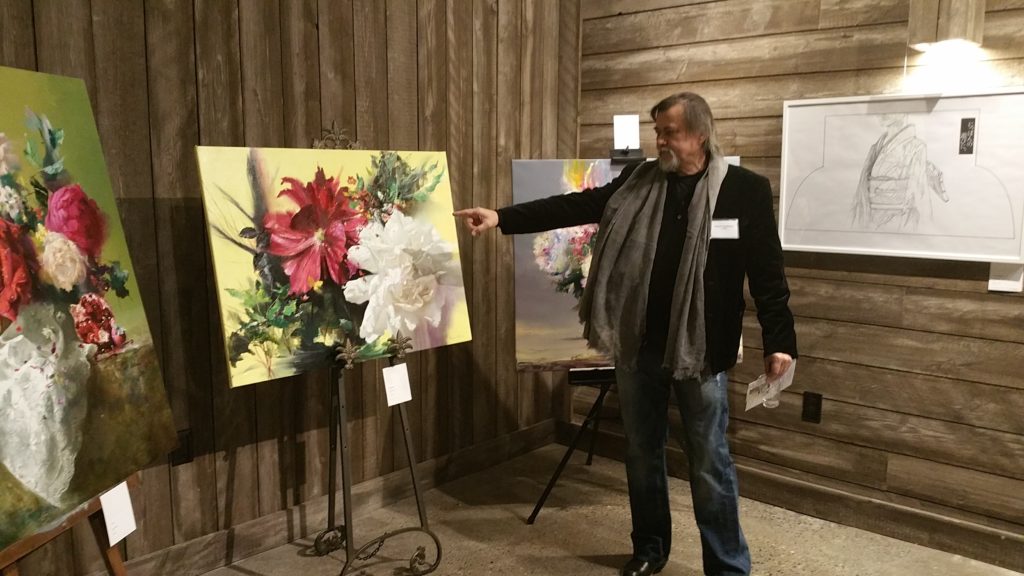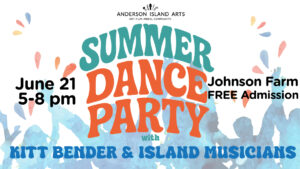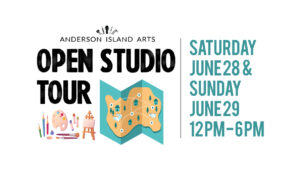Interview with Alexei Antonov
March 1st, 2018

Alexei Antonov at 5th Annual Anderson Island Art Show, Winter at the Farm
(We met with Alexei in his kitchen at his home on Anderson Island on March 1st of this year.)
For more information on Alexei Antonov’s art visit his website: www.antonovart.com.
Island Arts: We’re here with Alexei Antonov to do our inaugural interview for the Island Arts website. Tell us a little bit about yourself, Alexei, where you were born, your family and, perhaps, your early history.
Alexei: Well, I was born in Baku. It’s the capitol of Azerbaijan, on the Caspian Sea. It’s a former Soviet Union republic. I’m Russian; my parents immigrated from the Volga region during the 2nd World War because there was no food and it was a very dangerous place to live. So, they immigrated to Azerbaijan. Well, my Mom and Dad were like . . . Dad was a scientist and Mom was, like, my Mom. (chuckles)
Island Arts: She was home. She was a stay at home Mom?
Alexei: Yes. Well, my grandparents, especially from my mother’s side, he was a carpenter, very high quality like a furniture maker. And from my father’s side my grandpa was a watchmaker. So, probably from them I got the genes of crafting something with the hands and eyes. That’s pretty much where I come from.
Island Arts: When did you actually start painting or at least show an interest in the arts and get serious about it?
Alexei: Well, I remember myself from when I was 2 years old I believe because I remember some pictures from that period of time. I started painting with Mom’s lipstick. I always took her lipstick and painted on the wall paper.
Island Arts: (laughs) Her favorite artist?
Alexei: Well, that’s when it started. In school I didn’t have any interest in different disciplines, only art and singing sometimes. I was a pretty good student. All my life I’ve been drawing something, been painting.
Island Arts: Did they have art classes in your high school equivalent years?
Alexei: Yes.
Island Arts: Did you take them?
Alexei: I had to.
Island Arts: It was a requirement?
Alexei: Yes.
Island Arts: Did you like them?
Alexei: Yes, I like them. I was the best student.
Island Arts: Did they tell you that you were good?
Alexei: Yes, some of them, some of them not. I always saw myself as an artist, always. My friends saw themselves as firefighters. They dreamed of selling ice cream on the streets. I wouldn’t think about this. I was always thinking I would be an artist.
Island Arts: So, at what point did you go to the professional level of training where you specialized in the style of art that you’ve become famous for?
Alexei: Well, when I started out in art college they taught us more like Soviet realism which is based on the realistic theory, the realistic tradition and impressionistic tradition. It was kind of mixed. There was no fine detail there was none of the difficult Flemish masters technology. It was pretty much New School.
Island Art: So was the training for the art initially under the Soviet style like socialist realism, where you were considered a propogandist where they wanted you to promote the Soviet Union per se?
Alexei: No. Yes and no. They actually taught me something. They taught me how to deal with oil paint, how to use the brushes. And the role of propaganda, well, it was normal in the Soviet Union. If you find a job to do portraits of the political people who were ruling the government you were a lucky person. You could make a living. When I finished school and had to find a job, it was very difficult to find this kind of job. A group of government artists, they give you like a license, a very important-looking license, red color . . . Like a KGB license or something like that. But you don’t have a job; you have the opportunity to find a job and run it through the government but you have to find it by yourself. Every Tuesday people would go to a certain place and wait for a job. And I came and came and there was no job for me. And finally I wrote a letter to the director. I said, “Because I’m so hungry and I’m dying please give me the most unlikeable job that no one will take. I will take it.” They started laughing and asked me to come and they gave me a job. I painted a portrait of, I don’t remember who, it was Breshnev.
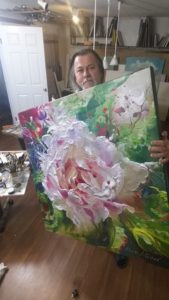
Alexei in his studio with one of his paintings.
Island Arts: You painted a portrait of Breshnev.
Alexei: Yes. And I started my career. But I didn’t pick up this propaganda seriously, only as a way to survive, a way to make a living.
Island Arts: Did Breshnev see the painting?
Alexei: I don’t think so. No. I painted it for someone else.
Island Arts: Was this still in Baku?
Alexei: Yes.
Island Arts: And this was early in your career?
Alexei: Yes, I was very very young. When I moved to Moscow after the Army I was starting to experiment with the Flemish masters technique. I started copying, I started reading books. I was still discovering. I pretty much covered everything available about this technique, about this period in history, the 16th century.
Island Arts: Did you teach yourself the technique, then?
Alexei: This particular technique, yes.
Island Arts: Yeah the Flemish technique.
Alexei: Yes.
Island Arts: So, within the Soviet system, they weren’t telling you, “We want you to paint in this style or that style.” You had the flexibility to develop your own style or did they . . . ?
Alexei: Well, they were looking for a more realistic style, but again the major school was more the impressionist style, like a pig, one layer of painting, careless composition, careless material, you know what kind of material they used. But if you made fine details, if your painting looked like the person whom you were painting you’re the best. So, they didn’t force me to do that.
Island Arts: Interesting. So, was there an actual market for your work in the Soviet Union?
Alexei: When I worked for propaganda, yes, there was like a market. But it was a government market. They had a certain amount of money to spend on this kind of art.
Island Arts: They had a budget?
Alexei: They had a budget. So, we had to take this budget. Sometimes we bribed the owners of new buildings. We would come and say, “You have money, you have a budget. Let me do your interiors. And 20% is yours. Well, okay, that’s good.” I would say, “Look, if you don’t spend the money this year, next year you will have less money.”
Island Arts: You have to spend it all or you don’t get it again?.
Alexei: We learned this very well. Bribery was everywhere.
Island Arts: What you said about the Russian you said was real simplistic, one layer of paint, is that the kind of stuff you see in the propaganda posters? You know you always see during the period of Stalin, you know, all the workers out there. That kind of stuff. Is it that kind of style?
Alexei: It’s close. But you’re talking about the genre. It’s separate, like posters.
Island Arts: So that’s not what you did?
Alexei: No.
Island Arts: Now, you did say you did some illustration work in one of your bios. What was that all about? What kind of work was that?
Alexei: Again, when I was off to Moscow. Times started being more free during the Gorbachev period of time when we had good relations with America and stuff like that. During this period of time I met lots of good people in Moscow, artists, musicians, especially rock groups. They needed advertising and I started doing posters for them.
Island Arts: Interesting. For musical groups?
Alexei: Yes, musical groups.
Island Arts: So these were posters for their events, for their concerts?
Alexei: Concerts, events, records.

"Black Belt Artist"
Island Arts: Did you keep copies of that kind of stuff?
Alexei: I have them somewhere but I don’t pay attention to it actually. So, it’s kind of gone. I was young.
Island Arts: (Laughs) It was just a way to pay the bills. Now you opened a gallery in Moscow, right?
Alexei: Yes.
Island Arts: Is it still open?
Alexei: It’s still open and in fact it still has the same name I gave it. It’s called Gallery Rubens.
Island Arts: Isn’t there a famous painter by that name? It’s named after him?
Alexei: Yes, Peter Paul Rubens.
Island Arts: And so you worked in Moscow. And obviously at some point you decided to immigrate to the US then?
Alexei: Well it wasn’t like I decided to immigrate. I decided to go for a visit with a friend of mine. He’s also an artist. He’s an iconographer. He paints icons; he’s a very religious guy. And I went with him to Alaska and lived in an orthodox Christian community. I took some paintings with me. And one gallery showed in an interest in my paintings. They gave me a one-man show and all of the paintings were gone on the first day. It was my best commercial success in America. Then little by little they created a business visa for me, then a green card. And to me like it’s led me where I am right now, where I can paint and nobody bothers me. And for now I feel like Anderson Island is my motherland. Because here people are dear to me and I have a perfect place to work. Nobody bothers me. There’s lots of inspirational things in the weather, the climate. And this is my place right now.
Island Arts: So, did you live in Alaska?
Alexei: Yeah, 4 years.
Island Arts: And then you moved down to here.
Alexei: Down to California. In California I had a contract with a gallery in Carmel. And this contact said that I could not sell my art from my home. I couldn’t sell art in California, only through them. And then I moved because I wanted to sell art from my home. So, I moved to Washington. I visited this island, fell in love, bought this piece of land, built this house and have been stuck here for more than 20 years.
Island Arts: So, in the mid-1990’s?
Alexei: Yes.
Island Arts: I’d say you’ve perfected this style and you’re also doing some work with what I kind of call “Rubens meets Dali”. (Laughs) I don’t know if that’s accurate or not but there’s kind of mixture of these two styles. When did you start experimenting with that and is that something that just sort of a sideline or do you see that as your new style?
Alexei: Yes, probably a new style. But how it happened. During my real artist period I learned the Flemish masters technique and developed and put together 6 teaching videos about this. And I have lots of written materials. What I learned from the books it’s very hard to find very organized tutorials on how to paint. You have to read about this artist, find this book, then try to find the writer about this artist, what he wrote about another artist. There’s so many things to learn. But I learned and during the last several years it’s gotten a little bit boring because I reached my ceiling. I couldn’t grow anymore.
Island Arts: With the Flemish style? The technique, you’ve mastered it.
Alexei: Yes, and it’s very hard to find something new. So, then I started thinking I need to bring in some more enjoyment and I started experimenting with my dreams you know my psychological feelings, my intuition and I started feeling like a young artist again. It’s like I started my second life. I started learning. I started looking at paintings. I started reading. It’s like a new epoch. I spent a good 4 or 5 years with this. We can call it surrealistic. It’s not exactly surrealistic, but there’s no name for what I’m doing. Yeah, like this. And right now I’m going a little farther. I’ve started doing the expressionistic style, more impressionistic. Cleaning my palette I find new colors, I find new happy accidents. And it’s given me an opportunity to change composition “on the go.” If it doesn’t go very well I just throw away the painting. I start a new one. Because the technique is very quick.
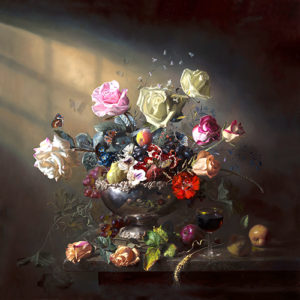
"Classika"
Island Arts: So, the technique for this style here (points at painting on the wall) is a lot less involved than your classic Flemish style? Is the underlying technique more or less the same but you’ve kind of eliminated some steps along the way or is it a totally different technique?
Alexei: We’re talking about 3 epochs. Classical Flemish masters (points to the still life), this portrait is more surrealistic (points to another painting) . . . And this is the latest one, expressionistic/impressionistic style, one layer technique. Sloppy.
Island Arts: This is done with one layer?
Alexei: Yes, this is actually a print. The original is twice as big.
Island Arts: Is the Flemish style always done with still life? Do they do portraits?
Alexei: They do portraits, of course. They made big compositions.
Island Arts: Do you like portraits?
Alexei: I like portraits, but portraits require lots of work with the people and I don’t like this destiny. I like to be my own boss. I like to serve my composition, what I think. But sometimes I do portraits. For example, my dentist’s kids. My first child when he was born, my 2nd child when was born in Alaska. I’ve painted kids’ portraits for my wife’s doctor. So, . . .
Island Arts: Oh fun, but he wasn’t probably very cooperative.
Alexei: I like to do trades with the doctors.
Island Arts: Have you seen the presidential portraits of Obama and his wife? Have you looked at those? There’s two new official portraits that are going to be in the national gallery. One of him and one of her. He’s in the flowers and she’s got a quilt on. What did you think of those? I don’t want to put you on the spot but I’m really interested. . .
Alexei: Her portrait I actually love. Her portrait because of the decoration, because of the composition. It’s more a piece of art than (President) Obama’s. Obama’s is kind of catchy, it’s like it’s not serious.
Island Arts: Do you have a favorite contemporary painter or historical painter?
Alexei: Yes, it’s only one guy. Jan van Huysum. Yes, he does flowers. Unbeatable. I can’t do how he does Peonies. I learned a lot from him.
Island Arts: And he paints this style?
Alexei: Yes, I learned a lot and he lived in the 16th century in Holland. They used to develop tulips; one tulip could cost one painting of Jan van Huysun. So that’s why he painted tulips, lots of tulips because they were very expensive. In America there are maybe 5 very good originals in the Jay Paul Getty museum.
Island Arts: So, in terms of your own paintings, do you have a favorite of yours? This is the height of my career.
Alexei: Usually I answer this question by saying my favorite painting is in the future. I can tell you my rating grew up a little bit last summer because one of my paintings was bought by a very famous rock musician. His name is Steven Tyler.
Island Arts: Yes. Steven Tyler.
Alexei: So that’s why my rating grew.
Island Arts: I’m sure that a lot of the value of art (in this country) is in who owns the art. A couple of high-visibility people who own your art, that just makes you more visible. Again, related to the Obama paintings, we both thought the painting of Barack Obama, we liked that better than the painting of Michelle Obama. And it’s interesting you liked the painting of Michelle Obama. How does that relate to your definition of fine art? How do you define fine art and is it even important to you, the definition and the debate over what constitutes fine art?
Alexei: Well, I think it’s a matter of taste. I feel in (President) Obama’s portrait there’s a little bit of Naïve style. You know Naïve?
Island Arts: Yes.
Alexei: Because this foliage has no perspective. It looks like it’s . . .
Island Arts: It’s one dimensional.

"Dichotomy"
Alexei: Yes. Not really professional. But some people understand Naïve and like Naïve. And I respect that. Maybe in the future I will do something Naïve, too. I don’t know. But right now I’m more on the Michelle side, on the live dress, on the bold composition, very contemporary. It’s very eye-catching from a distance. From a bunch of pictures on a screen you can point at this dress, you know. In a little square. But faces? I’m not sure. In a painting I look for composition and the colors and things like that. I guess it’s not only about paintings, it’s about art, about music, about literature, about poetry. The professionalism, something which is indescribable. . . for example, musicians. One musician will play every note (Alexei then sounds out the notes to the beginning of the Star Spangled Banner in a very straightforward way). Everything is perfect, all the notes are there. But another musician can play like (Alexei then sounds out the Star Spangles Banner with quite a bit of interpretation in the notes) you know, a little bit of disharmony, a little bit stretched out inside notes.
Island Arts: With more feeling?
Alexei: He’s kind of creating something with the notes. He brings his own mistakes, his own soul you know? And if he did it right it’s real art, if he did it wrong, it’s bad art. Something like that. There’s lots of feelings, different quality of feelings. Where to put the spotlight, the focus light. Where contours must disappear or appear. And again, if you do this mechanically you know the artist is supposed to make this, for example, (points at painting) shadow line disappear. You know like this line is not supposed to be there. This sharp line has to be here. But, if you do this automatically it’s not a fact it will be good. It depends on what’s inside of you. It’s like all people are different. One person is smart, another is not that smart. One person has better feeling and another doesn’t. It’s the same thing with artists and musicians. It depends on their personality. Sometimes you see great art and you start reading about the artist he was an awful person. He was not good at all. He was not good with people. How was he able to produce?
Island Arts: Do you use much modern technology when you’re painting?
Alexei: Lately, yes.
Island Arts: What has it been?
Alexei: I like computer gadgets. I like playing with different things. Right now I have a new IPod Pro with a pencil and I have so much fun. It’s breakthrough technology for artists. You can draw just like on a piece of paper.
Island Arts: Do you incorporate that into . . . just sort of experimenting with that for fun or are you trying to incorporate that into your repertoire of work?
Alexei: I try as much as possible to learn something new. For example, when I was growing up I tried to choose my friends from people older than me to learn from them, to learn information. Now I try to make friends with younger people because I know they are smarter than me.
Island Arts: (Laughs) I taught technology. I know they are smarter.
Alexei: So, that’s why I learn. I’m thinking what can I do for my art with this? And right now I find it much more appropriate, for example, I take a picture of a painting in progress and immediately I start to try different things on the screen. How to change, what to add, what to get rid of. It’s already a big plus. I don’t make a mistake on the canvas, I make a mistake on the screen.
Island Arts: So it’s a form of editing your work in a way?
Alexei: Yes, editing, composing.
Island Arts: It’s much faster.
Alexei: Faster, yes, and more appropriate.
Island Arts: You probably experiment more because it makes it friendly to use.
Alexei: Yes.
Island Arts: So are you. . . you see some art where they are using computers in the actual art itself. You can see it in photography, like in Photoshop.
Alexei: There are lots of artists right now who make a painting right on the computer then paint it out and sell limited editions and stuff like that. But this is also a limited edition (points to one of his paintings hanging on the wall). It’s a print on canvas from the original. I use lots of Photoshop before I start to do real composition on the canvas because it’s easier to balance. On the canvas if you make a mistake it’s very hard to correct it. And I believe if Leonardo da Vinci were living in our century he would have the most sophisticated computer technology.
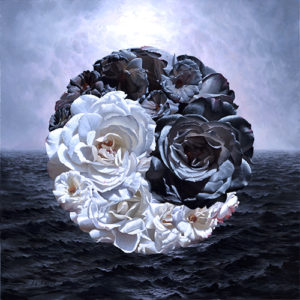
"Untitled"
Island Arts: You know, I think that’s true. He was a scientist after all. He’d have them lined up. He’d have big screens. You taught a class out here, a number of classes. Do you like teaching?
Alexei: Yes, I love it. I like it. I’ve been so surprised when I started to do this. So many people here on the island who like to paint. I have been pleasantly surprised how many people. They’re waiting for me to do it again. But my studio is getting tighter and tighter. I have more and more stuff. I need a new studio or I need to get rid of a bunch of things.
Island Arts: Well, at our last art show in January there were 33 artists and photographers. But aside from the photographers, there were a good 25 to 26 artists, most of them from the island.
Alexei: The island has some kind of magic.
Island Arts: That’s great. What would be your advice to someone who wants to become a professional artist or at least a serious artist?
Alexei: Well, no compromise. If you want to have this career, no compromise with a good dad, good husband or good wife. Only an artist. You are not a wife anymore. You are only an artist.
Island Arts: Oh my God, that’s serious.
Alexei: You have to suffer with lots of normal human being things. My poor wife has been with me for 30 years, more than. While I was growing she was around but I always said I’m an artist in the first place and a dad and husband in the second.
Island Arts: Oh gosh, so she did it all, huh? She’s not an artist herself?
Alexei: Thank God, no.
Island Arts: I was going to ask you before we close up here, you’ve painted primarily. You made mention that you were told you were good at art and you were good at singing. Do you still sing?
Alexei: Not really. But I love to play on the piano. I don’t know notes. I like to play avant garde. I love any new form of music. I always search for new names. My favorite style is fusion, the fusion of jazz, classical and folk music. Like Chicago, Blood, Sweat and Tears. Do you remember those names?
Island Arts: Oh yes.
Alexei: Right now there’s a new young guy. He’s 23 years old. Last year he had 4 Grammy awards. His name is Jacob Collier. He’s a fantastic guy. He’s a great composer. He composes better than Mozart. He’s composed the most difficult compositions. He’s created a new kind of harmony. He teaches. Very big musicians are following him right now.
Island Arts: Wow, is he a jazz fusion guy?
Alexei: It’s kind of the next step of fusion I can say. The next step. It’s something new.
Island Arts: Wow. Jacob Collier. Glenn will go home and look him up right away.
Alexei: I always listen to him right now.
Island Arts: My other question I had is, have you ever done anything besides painting that has to do with art, like sculpture or anything like that?
Alexei: Not really. When I studied art in college, yes, I did some sculpture and I was pretty good at it. But there’s no facility. If I had a big studio I’d probably have a corner with sculptures. But there’s no place for me to do it here.
Island Arts: So you need a bigger place, huh?
Alexei: Yes.
(This concluded our interview with Alexei Antonov Island Arts appreciates his time and effort in helping us put this project together.)
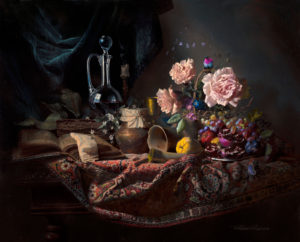
"Untitled"

